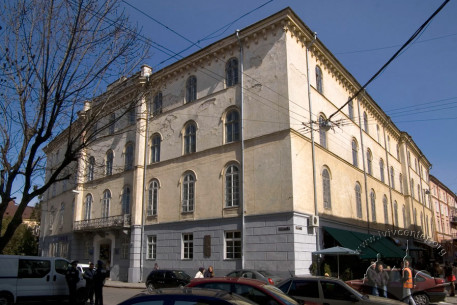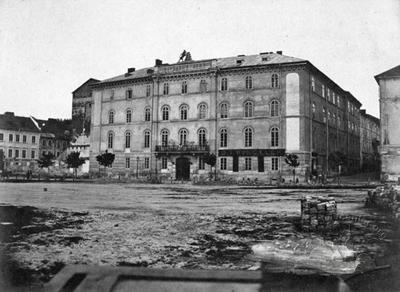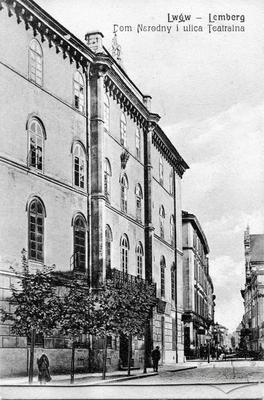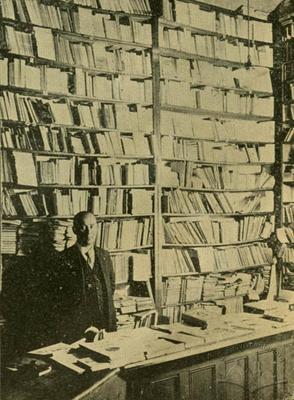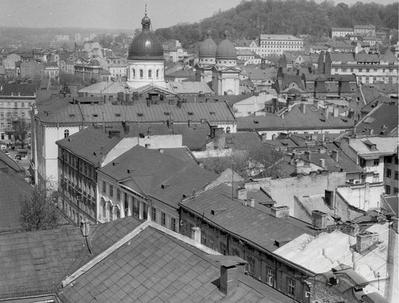Vul. Teatralna, 22 – The House of Officers (former Peoples’ House) ID: 2345
The Peoples’ House was constructed in the years 1851-1864 under a project drawn up by Wilhelm Schmidt; a slight echo of the Romanticism and Biedermeier can be seen in the Neo-Classicist architecture of the building. The society of Halytsko-Ruska Matytsia and its editorial office were located there, as well as some other public organizations; later the building was occupied by the Rozmaitości theatre. According to the resolution of the Lviv regional executive committee number 381 dated 5 July 1985, the building of the Peoples’ House was entered into the register of local monuments under protection number 295. As for today, the building houses the District House of Officers for the Western Operational Command, the Cinema Palace, a few cafés and a dancing studio.
Story
1703-1727 – the Trinitarian monastery building is erected.1783 – the monastery is abolished.
1784 – Lviv university and the academic gymnasium are located in the former monastery.
2 November 1848 – the university building is destroyed by fire.
1851-1864 – the Peoples’ House is constructed under a project drawn up by architect Wilhelm Schmidt.
1928 – the building’s interior is reconstructed (architect Aleksandr Kapłoński).
1930 – the ballrooms are reconstructed for the purposes of the Rozmaitości city theatre (architect Adam Opolski).
The idea to create the Peoples’ House was first announced by Lev Treshchakivskyi, a public figure and a member of the Supreme Ruthenian Council (Holovna Ruska Rada), at a sitting of the Council on 15 June 1848. It was to be done due to donations of the whole Ukrainian population of Eastern Galicia, with the purpose of the growth of spiritual culture in view. The proposal was adopted. The Peoples’ House was then built in place of the charred ruins of the old university located on Krakivska street, in the premises of the Trinitarian monastery, which had been abolished by the Austrian government.
The monastery was built in 1703-1727 and functioned till 1783. After it was abolished, the building was given to Lviv University which occupied it from 1784 together with the Academic gymnasium. Yakiv Holovatsky and Markian Shashkevych, future members of the Ruska Triytsia (Ruthenian Triad), studied here. During the revolutionary events of 2 November 1848 the university building, along with the valuable university library located in the former Trinitarian church (now the Transfiguration church), was destroyed by fire. In 1849, after a short interval, the university was temporarily transferred to the city hall where it occupied 13 rooms on the third floor; in January of 1851 it was given the premises of the former Jesuit convict, and still later, the military barracks on Mikołaja (now Hrushevskoho) street.
In 1849 the Supreme Ruthenian Council applied to the Ministry of the Internal Affairs of the then Austrian government, requesting that the Ruthenian peoples be granted the charred ruins of the former Trinitarian monastery to build the Peoples’ House there, and the ruins of the Trinitarian church, where the university library had been located, to construct the second city church there. The first one was the Dormition church on Ruska street. In November of the same year the ruins of the university and library were transferred to the possession of the Supreme Ruthenian Council, that is, of the Ukrainian population of Lviv. In 1850 the Council announced a money collection campaign in the whole region for “the construction of a peoples’ institution and providing support for its functioning.” An appeal, issued by the Supreme Ruthenian Council, called upon the whole Ukrainian population to “build a Peoples’ House which will be of common and useful interest for all the Galician-Ruthenian people…”
The building of the Peoples’ House, in its current appearance, was constructed in 1851-1864 under a project drawn up by architect Wilhelm Schmidt. Sylvestr Havryshkevych, an architect, also took part in the construction; it was under his project that the former Trinitarian church was reconstructed as the Transfiguration church (completed in 1898).
A number of cultural and educational societies and institutions functioned in the Peoples’ House. In 1862 the first Ukrainian academic gymnasium was transferred to the House; the gymnasium had previously been located in the premises of the Bernardine monastery. A seminary boarding school was opened there too. Due to the efforts of Anton Petrushevych, a well-known historian and linguist, a library was arranged, which had a valuable collection of Slavic old printed books and manuscripts of the fifteenth-nineteenth centuries. The books and manuscripts from this library were used by Ivan Franko. In 1914 the library and seminary boarding school were transferred to a newly constructed building on Kurkowa (now Lysenka) street 14; the project was designed by architects Tadeusz Obmiński and Oleksandr Lushpynsky.
The society of Halytsko-Ruska Matytsia and its editorial office were located in the Peoples’ House where popular science books were published. Later the society obtained its own building on Żołkiewska (now Bohdana Khmelnytskoho) street 28. The institute published a monthly entitled Vistnyk Narodnoho Domu (The Herald of the Peoples’ House) which included chiefly articles on history. In different periods of time some other public organizations, for example, Narodna Torhivlia (Peoples’ Trade), Kazyno Ruske (Ruthenian Casino), the political society of Ruska Rada (Ruthenian Council), also were located there. It must be mentioned that in 1882, when the archaeological exploration of old city Halych was started, the funds for the excavations were appropriated not only by sponsors, but also by the institute of the Peoples’ House.
The Ruthenian Peoples’ Theatre acted in the great hall of the Peoples’ House from 1864 till 1876, with some intervals; also, the artistic exhibitions of the Fine Arts Society were held there. The exhibitions of Lviv painters Wilhelm Leopolski, Kornylo Ustyianovych, Teofil Kopystynskyi and some others were organized there in May of 1877. Anton Rubinshtein, a well-known Russian composer and pianist, gave a concert in the Peoples’ House on 17 January 1879.
In the early 20th century a reconstruction of the interior was made (1928, architect Aleksander Kapłoński); in 1930 the ballrooms were reconstructed according to design by architect Adam Opolski for the purposes of the Rozmaitości city theatre.
Since 1 September 1944, the District House of Officers for the Lviv Military District (now Western Operational Command of the Armed Forces of Ukraine) has been located in the building. Apart from that, the Cinema Palace, a few cafés and dancing studios are located there today.
Architecture
The building of the Peoples’ House is situated on Teatralna street, its side façades facing Virmenska and Lesi Ukrainky streets. The architect partly used some fragments of the Trinitarian monastery building constructed in the eighteenth century, having preserved even the curvature of the façade facing Teatralna street. As for the style features, a slight echo of the Romanticism in architecture as well as that of the Biedermeier can be seen in this monument. Among the three façades of the four-floor building, the façade from the side of Korniakta street is richest in plastic art. The two-floor theatre hall location can be recognized on this façade due to the wall projection and big arched windows.People
Adam Opolski – an architect.
Anton Petrushevych (1821-1913) – a Ukrainian historian and linguist, a priest.
Anton Rubinshtein (1829-1894) – a Russian composer and pianist.
Ivan Franko (1856-1916) – a Ukrainian writer, scholar, public figure.
Kornylo Ustyianovych (1839-1903) – a Ukrainian painter.
Lev Treshchakivskyi (1810-1874) – a priest, public figure and member of the Supreme Ruthenian Council.
Markian Shashkevych (1811-1843) – a priest, budytel (the one who awakes), Ukrainian poet and public figure
Oleksandr Lushpynskyi (1876-1943) – a Ukrainian architect.
Sylvestr Havryshkewych (1833-1911) – a Lviv architect.
Tadeusz Obmiński (1874-1932) – a Lviv architect.
Teofil Kopystynskyi (1844-1916) – a Ukrainian painter.
Wilhelm Leopolski (1828-1892) – a painter and art critic.
Wilhelm Schmidt (19th c.) – a Lviv architect.
Yakiv Holovatskyi (1814-1888) – a Ukrainian linguist, ethnographer, student of folklore, historian, poet, Greek-Catholic priest, educator, public figure.
Organizations
Sources
- Державний архів Львівської області (ДАЛО) 2/2/5248.
- Архітектура Львова. Час і стилі XII–XXI ст. (Львів: Центр Європи, 2008), 293-294.
- Володимир Вуйцик, "Народний Дім", Leopolitana ІІ, (Львів, 2013), 201-204
- Володимир Вуйцик, Державний історико-архітектурний заповідник у Львові (Львів, 1991).
- Володимир Вуйцик, "Народний дім у Львові", Вісник інституту "Укрзахідпроектреставрація", 2004, Вип. 14, 164-165.
- Г. М. Сіромська, "Фінансово-господарська діяльність "Народного дому" у Львові", Слов'янський вісник, 2010, Вип. 10, 126-131.
- Ігор Копиляк, "Театральні приміщення в історичних українських культурно-просвітницьких будівлях (на прикладі Львова)", Вісник Національного університету "Львівська політехніка", 2009, №659, 161.
- І. Орлевич, "Боротьба між українофілами та русофілами за "Народний дім" у Львові", Вісник Львівського університету, 2007, Т. 7, 339-358.
